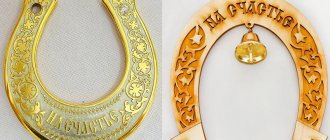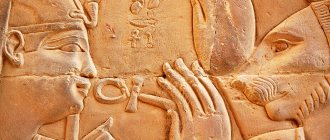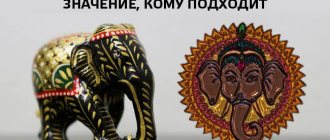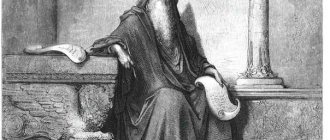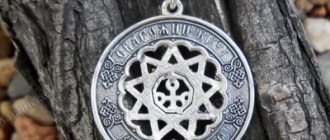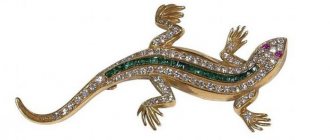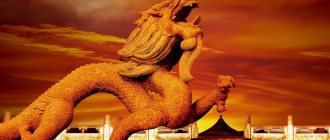According to one Tibetan legend, when the Divine Sage achieved Perfect Awakening, he was presented with eight symbols called auspicious ones. Now they are very popular both in Tibet itself and in countries where Buddhism came through the northern branch. These signs are very ancient and are present in religions such as Hinduism and Jainism. They can also be found on the walls of Buddhist monasteries, and, of course, in the houses of believers. In this article we will look at eight symbols of Buddhism and reflect on their meaning.
The history of the appearance of Buddhist symbols
There is a beautiful legend about how eight auspicious symbols appeared in our world.
According to this legend, on the day Buddha attained enlightenment and higher wisdom under the sacred tree, many gods came to pay their respects and presented him with gifts - eight auspicious symbols.
Brahma presented the deity to the Enlightened One with the Dharmachakra (Wheel of Learning). The heavenly god Sakra gave the White Shell to spread the wisdom of the Buddha to each end of the Universe. The earthly god Stavara handed the Buddha a Precious Vessel full of the drink of eternal life. The remaining gods presented Buddha with a pair of Golden Carps, a Lotus, a Victory Banner and a Good Umbrella.
All these symbols in Buddhism became sacred, demonstrating the close connection of the divine with the human world.
We have selected interesting articles for you:
Yin and Yang: meaning, translation, hidden meaning, history of appearance
19.12.2021
What is the secret of God's many-armed nature?
21.12.2021
Buddha images
Siddhartha Gautama did not encourage worship or veneration from his followers, and images of both himself and his teachings do not date back to his lifetime. However, the enlightened one used metaphors and images in his sermons, for example, talking to his disciples about turning the wheel of Dharma.
The main symbols of Buddhism and their meaning became known after the death of the Enlightened One, and were mainly images reflecting his teachings. The earliest sacred signs were the stupa and the wheel of Dharma.
The symbolism of Buddhism expanded as it spread and divided into different traditions. It was enriched by the cultures with which religion came into contact.
The following symbols were mainly used to depict Buddha in the early stages:
- Wheel with eight spokes. Another name is Dharmachakra. It means Buddha turning the Wheel of Truth and changing the course of fate.
- Bodhi tree. It is believed that it was under him that Gautama achieved enlightenment.
- Buddha's footprints. According to legend, the ruler of the spirit world left his footprints on the stone, which would remind of his presence on Earth.
- Empty Throne. A reference to Siddhartha Gautama's royal lineage and the idea of spiritual kingship.
- Begging bowl. Symbolizes the Enlightened One’s refusal of all material values. In addition, the cup indicates the lifestyle of a monk.
- A lion. One of the most powerful symbols. Traditionally, the lion is associated with royalty, strength and power.
Much later, images of Buddha's eyes appeared (most often on stupas), which are often found in Nepal. The eyes look in all four directions, representing the omniscient mind of the spiritual ruler.
Umbrella
The precious umbrella is the last auspicious symbol of Buddhism. While a person follows the path of Enlightenment (achieving Buddha nature), the sign helps him in overcoming obstacles.
Traditionally, the sun umbrella symbolized protection as well as royal majesty in India. Since it was held above the head, it naturally symbolized respect and honor. For secular rulers, umbrellas were made from peacock feathers. In the religious consciousness of most people, protection from bad weather was associated with protection from vices, pollution and passions that interfere with spiritual development. That is, just as a simple umbrella saves us from the rays of the sun or rain, its precious counterpart protects us from obstacles on the path to Awakening.
The Tibetan version of the umbrella shape was borrowed from the Chinese and Indians. The prototypes consisted of a silk dome and a wooden frame with spokes. There was fringe or frill along the edges. The silk was red, yellow, white or multi-colored, and the stem was dyed exclusively red or gold. In Tibet, the status of the owner could be determined by looking at the umbrella. Moreover, he was a symbol not only of secular power, but also of spiritual power. According to ancient legends, Teacher Atisha was revered to such an extent that he was given thirteen umbrellas to accompany him.
Victory Banner
This symbol of Buddhism signifies the triumph of Dharma over ignorance, as well as the passage of the obstacles of Mara. This banner is located on the top of a mountain called Sumeru. As long as the Universe exists (the Heaven of Brahma and the World of Passion), this mountain of Perfection will be indestructible. Consequently, it is simply impossible to destroy the teachings of the Savior.
Types and meaning of Buddhist amulets
Buddhism is a religious doctrine whose founder is considered to be the Indian prince Siddhartha Gautama. When he was 29 years old, he left his kingdom, his family, his little son and went in search of the meaning of life.
There are various amulets in the Buddhist religion. They are made from wood, stones, paper, clay. Talismans made of precious metals - gold, silver - are considered powerful and valuable. Sacred symbols and images are applied to the body in the form of tattoos.
Buddhism amulets are intended for specific purposes:
- drive away evil spirits;
- Buddhist symbols help achieve inner harmony;
- destroy the harmful effects on personal energy;
- get luck, health, wealth.
Buddha or other bodhisattvas
Images, figurines of Buddha or cult personalities are used as amulets. Objects are made of clay, metal, drawn on paper, canvas. Buddha personifies devotion to faith, the search for the true path to get rid of suffering.
Tibetan lamas and ordinary followers of the religion believe that there are deities endowed with intelligence, 8 classes and subclasses of spirits. Common Buddhist magical amulets are:
- Samantabhadra. Represents the Buddha, the enlightener, the revealer of the true understanding of things;
- Amitayus. Increases the positive energy of the individual, improves health;
- Amitabha. The sign accelerates the achievement of Nirvana and promotes successful subsequent rebirth;
- Mahakala. The Buddhist symbol protects against evil forces, protects health;
- White Mahakala. The amulet forms reliable protection for the owner;
- Chakrasamvara. Provides enormous opportunities;
- Vaishravana. Increases material well-being, helps achieve what you want;
- Trimurti. Triune Buddhist deity, protecting against diseases, helping to achieve omnipotence;
- Vajrakilaya. An angry god who prevents damage, the evil eye, and the phenomena of black magic;
- Shakyamuni. The amulet is suitable for those who have firmly decided to take the path of self-knowledge and purification.
The list of avatars of Buddha and other deities helps people by exerting a clearly targeted effect on the owner.
Sacred plants or animals
Buddhists are sensitive to flora and fauna; many animals and plants are considered sacred. Creatures are represented on jewelry in the form of symbols for protection from negativity:
- Lotus in the form of a flower or bud. Buddhist sign of the waters from which the world was born, wisdom, enlightenment, perfection.
- Goldfish. A paired amulet that prevents quarrels in the family and gives wealth. It means the duality of human nature, the renunciation of material things.
- Elephant. The personification of spiritual perfection. The animal announced to Buddha's mother the birth of a child.
- Tiger. In the Buddhist religion it symbolizes power. A tattoo with an animal gives strength to the owner.
- Cat. Represents home. Animal images are a protective talisman for the family.
Amulets with animals are often painted on the body or made in the form of figurines. They are installed in homes to cleanse the premises from negative influences and to increase the good.
Mandalas
If a person is not associated with Eastern beliefs and traditions, Buddhist mandalas are suitable as amulets. They are patterns, outlines of symbols used in yoga to concentrate thoughts and spiritual improvement.
Geometric figures used in Buddhist mandalas symbolize the model of the Universe. They have a complex structure and indicate that all processes in the world are interconnected.
Other
There are many revered symbols that are used in the form of Buddhist talismans:
- "Om" sign. The syllable is considered sacred. From it the Universe and everything that exists was born. The symbol is written on paper, canvas, or carved out of wood;
- white umbrella. A talisman against bad moods and thoughts;
- bowl. Represents a vessel full of the nectar of longevity. The amulet bestows health and long life;
- white shell. Buddhist symbol of purity, pleasure;
- node Means endless life, helps to direct energy flows;
- victory banner. The sign helps in overcoming internal obstacles;
- wheel of samsara. A talisman for achieving wisdom, liberation from a series of reincarnations;
- diamond amulet. This is the name given to paper with a black and red image printed on it. Monks consider such Buddhist talismans to be the most effective;
- a talisman that frees you from karmic debts. The process of creating an amulet is one of the simplest: the text of the mantra is applied to a white sheet with red paint;
- talisman in the form of the Padmosnisha mantra printed on paper. It helps the owner in achieving enlightenment;
- Padmasambhava Terma with Buddhist spell texts for protection from evil;
- Dzi beads. The amulet is widespread in Tibet. The history of its appearance is completely unknown. The talisman protects from evil and changes a person’s life for the better. Each bead has its own meaning. Passing them on by inheritance or giving them to another is strictly prohibited;
- Ryu's amulet. Tantric talisman that protects against the evil eye and damage. It improves the condition of the mentally ill, gives peace of mind;
- Red thread. A popular amulet found in many cultures and in the Buddhist religion. Protects from diseases and negativity.
When purchasing Buddhist amulets, you should seek the advice of monks.
How to use it correctly
Today, the infinity knot is more often used as an amulet that must be worn on the body. It can be made from wire, rope, tape and even painted on clothing. If the sign is depicted on home decor items, then good luck will accompany all family members.
Activation
In order for the Tibetan mystical symbol to gain energy and serve as a strong amulet, it is necessary to invest the energy of your desire into it during weaving.
You should concentrate on one thought and imagine how it penetrates the knot.
It is also recommended to listen to Tibetan mantras, which will help set your mind to the right rhythm and transfer it to the talisman.
Precious vessel
Belongs to the category “The most beautiful symbols of Buddhism”, pictures of which are present in any Buddhist temple. This is a sign of health, long life, as well as prosperity and wealth. The lid of the vessel is decorated with a jewel called cintamani (translated from Sanskrit - fulfilling one's plans).
You already know that Buddhist symbols can have several interpretations. So the contents of the jug have two interpretations. The first says that there is the nectar of immortality inside. Remember, Buddha Amitayus and Padmasambhava’s disciple Mandrava kept such a jug with the elixir of immortality on the thangkas. They gained eternal life and forgot what aging and death are. On the other hand, the Teachings of the Buddha say: in the Three Worlds nothing can be eternal, only our true nature is eternal. By applying longevity practices, a practitioner can significantly prolong his existence and eliminate life’s obstacles. The main obstacle is energy shortage. Extending life is especially valuable if a person practices to achieve Liberation, improves in compassion and love, accumulates wisdom and merit, thereby becoming needed by other beings.
According to the second interpretation, this vessel is filled with jewelry. Moreover, you can take as many of them as you like, it does not become empty. What do the jewels symbolize? These are good rewards for beneficial deeds performed by people. One who accumulates positive karma will definitely reap the fruits of happiness.
Sink
Like other symbols of Buddhism, it has its own meaning. A white shell with a spiral twisting to the right is considered a sign of the Savior’s enlightenment, as well as good news to all beings about the opportunity to achieve his nature. In ancient times, the conch shell was a musical instrument (wind instrument). It is therefore not surprising that it symbolized sound that spread in all directions. Likewise, the teachings of the Buddha are transmitted everywhere, calling on all beings to awaken from the sleep of ignorance.
Most often in nature there are shells in which the spiral twists to the left. Shells with a right-handed spiral are very rare. It was they who were associated in the minds of people with special characteristics and were considered sacred. The direction of their spirals was associated with the movement of celestial bodies: stars, planets, including the Moon and the Sun.
Lotus
The lotus flower is a symbol of holy compassion and love. And these two feelings are included in the four immeasurables and help to find the path to the soul of the Bodhisattva. The white lotus symbolizes holiness and spiritual purity. Pink is considered the sign of the Savior, that is, the Buddha himself.
The lotus roots go into the mud, its stem passes through the water column, and its petals rise above it. They are open to the sun and clean. There is no defilement in the consciousness of an enlightened person. The three root poisons cannot poison the mind of a saint, just as dirty water cannot remain on the unsullied petals of a lotus.
Endless knot
Some Buddhist symbols have multiple interpretations. And the endless knot falls into this category. For some it is the endless cycle of existence, for others it is a symbol of eternity, for others it is a sign of the inexhaustible knowledge of the Buddha. It is also a sign of the interdependence of all events in the Universe and the complex relationship between compassion and wisdom in the process of achieving Enlightenment. And to achieve it, you need to overcome the endlessly long path of the Mahayana. The path of the Bodhisattva is quite long and includes many kalpas.
There is also a hypothesis that the endless knot reflects another symbol, consisting of 2 intertwined snakes. The snake is one of the most ancient signs of kundalini, which came to India from Ancient Egypt. Most likely, the endless knot has a connection with the chandali. This is supported by the theory that the intertwining serpents are very similar to the movement of kundalini through the left and right channels of the etheric body.
